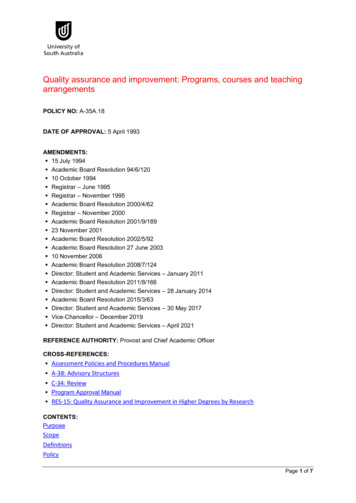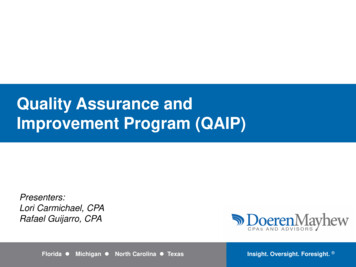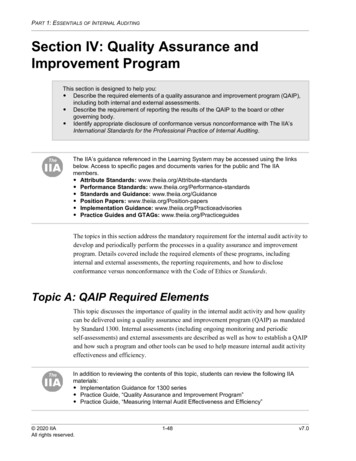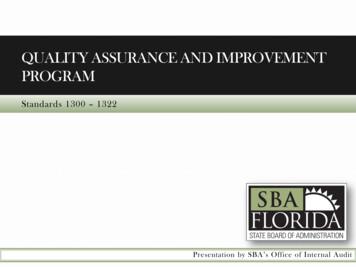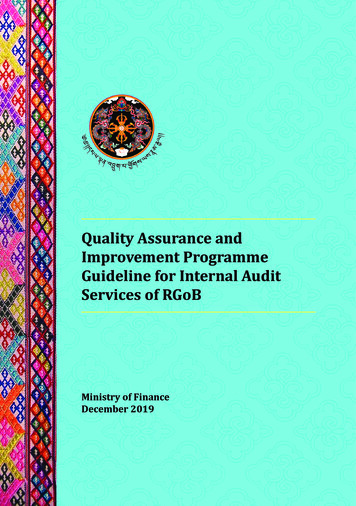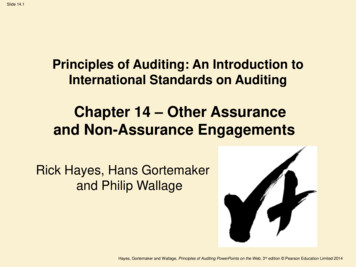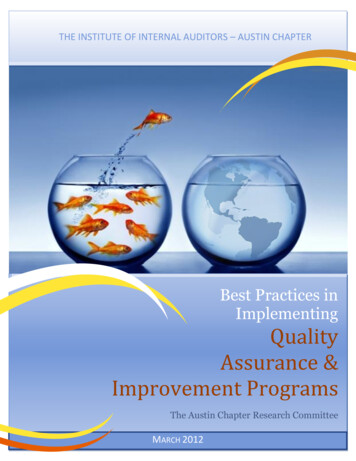
Transcription
QUALITY IMPROVEMENT ANDQUALITY ASSURANCEDefinition of Quality Assurance and Quality ImprovementQuality Assurance - “a program for the systematic monitoring and evaluation of the various aspects of aproject, service, or facility to ensure that standards of quality are being met”1Quality Improvement - “Quality improvement in public health is the use of a deliberate and definedimprovement process, such as Plan-Do-Check-Act, which is focused on activities that are responsive tocommunity needs and improving population health. It refers to a continuous and ongoing effort to achievemeasurable improvements in the efficiency, effectiveness, performance, accountability, outcomes, and otherindicators of quality in services or processes which achieve equity and improve the health of the community.(R. Bialek, L. M. Beitsch, A. Cofsky, et al, unpublished data, 2009)”2The Difference Between Quality Assurance, QualityImprovement and EvaluationThe terms Quality Assurance (QA) and Quality Improvement (QI) are frequently interchanged which makes itdifficult to understand the differences between these terms. This “interchangeability” also creates confusionwhen applying quality concepts to our work. Public Health frequently uses QA methods when reviewing clientrecords against a standard quality indicator tool, to assure quality services are maintained according to setstandards (e.g., federal, state, American Academy of Pediatrics, etc.). Quality Assurance processes allow us toidentify flaws in processes that prevent us from achieving set standards. Once the flaws are identified, we canthen initiate QI processes through models such as Plan, Do, Check and Act (PDSA) to improve or eliminate theflaws identified by the QA processes. Click on the below presentation for an overview defining quality, QA,and QI in Public Health.3PHN Manual10/2020Page 1 of 8
QUALITY IMPROVEMENT ANDQUALITY ASSURANCEIn addition to the importance of understanding the difference between QA and QI, we need to also understandhow QA and QI related to evaluation. Evaluation assesses work at defined data points such as comparing clientrecord review data between quarters or years. The following diagram taken from the American Public HealthAssociation, Quality Improvement in Public Health: It Works! fact sheet on page 4, shows the relationshipbetween QA, QI and evaluation.4To view the complete American Public Health Association, Quality Improvement in Public Health: It Works!fact sheet, visit: https://www.apha.org/ /media/files/pdf/factsheets/qi in ph it works.ashxPHN Manual10/2020Page 2 of 8
QUALITY IMPROVEMENT ANDQUALITY ASSURANCEStatutory Requirements for Quality Improvement andQuality Assurance in NC Public Health DepartmentsChapter 130A. Public Health. Article 1. Definitions, General Provisions and Remedies. Part 1. GeneralProvisions, 130A-1.1 (a) (6) and (7) Mission and essential servicesChapter 130A. Public Health. Article 1. Definitions, General Provisions and Remedies. Part 1. GeneralProvisions, 130A-1.1 (a) (6) and (7) Mission and essential services addresses the mission of the public healthsystem is to promote and contribute to the highest level of health possible for the people of North Carolina toinclude, among other requirements, the promotion of the availability and accessibility of quality health careservices through the private sector; and providing quality health care services when not otherwise available.Also, under 130A-1.1 (b) (7), there is a requirement to evaluate the effectiveness, accessibility, and quality ofpersonal and population-based health statutes/pdf/bychapter/chapter 130a.pdfCHAPTER 46 ‑ LOCAL STANDARDS, SECTION .0100 ‑ GENERAL SECTION .0200 – STANDARDSFOR LOCAL HEALTH DEPARTMENTSCHAPTER 46 ‑ LOCAL STANDARDS, SECTION .0100 ‑ GENERAL SECTION .0200 – STANDARDS FORLOCAL HEALTH DEPARTMENTS addresses the requirement for local health departments to implement aquality assurance program assessment in accordance with:10A NCAC 46 .0203QUALITY ASSURANCEA local health department shall establish, implement, and maintain written policies to assure quality in alladministrative, environmental, clinical, and educational services and activities mandated by the Commissionwhich are contracted for or provided by the local health department. Policies shall include:(1)Provisions for a periodic program assessment to be conducted at least once per year which shallinclude:(a)A review of appropriate clinical and non-clinical records.(b)Development of a corrective action time-table for making necessary improvements.(c)Representation in the quality assurance program of each discipline involved in serviceprovision.(d)A review of appropriate state or local reports and statistics.(e)Documentation of review findings.(f)Documentation of corrective action.(2)Provisions for staff development and training 0rules.htmlPHN Manual10/2020Page 3 of 8
QUALITY IMPROVEMENT ANDQUALITY ASSURANCEArticle 2. Local Administration. Part 1. Local Health Departments. 130A-34.1. Accreditation of localhealth departments; board established.In 2002, the North Carolina Division of Public Health and the North Carolina Association of Local HealthDirectors undertook an initiative to develop a mandatory, standards-based system for accrediting local publichealth departments throughout the state. This initiative is based on Article 2. Local Administration. Part 1.Local Health Departments 130A-34.1 Accreditation of local health departments; board on/Statutes/PDF/ByArticle/Chapter 130A/Article 2.pdfThe focus of North Carolina’s Local Health Department Accreditation (NCLHDA) is on the capacity of thelocal health department to perform at a prescribed, basic level of quality the three core functions of assessment,assurance, and policy development and the ten essential services as detailed in the National Public HealthPerformance Standards Program. The program focuses on a set of minimal standards that must be provided toensure the protection of the health of the public but does not limit the services or activities an agency mayprovide to address specific local needs. NCLHDA does not create a wholly new accountability system; rather itlinks basic standards to current state statutes and administrative code, and the Division of Public Health andDivision of Environmental Health contractual and program monitoring requirements that are already in place.To support the “basic level of quality” required under NCLHDA, local health departments must evaluate theeffectiveness, accessibility, and quality of personal and population-based health services in achieving desiredoutcomes. Benchmark 27 in the Health Department Self-Assessment Instrument Interpretation Documentbegins the quality and performance improvement processes for the agency. It is the benchmark that examinesthe ninth essential service (see 10 Essential Public Health Services below). It explores how the department canappraise its services by looking at how effective those services are, by seeing how easy it is for residents toaccess those services and by reviewing the overall quality of services. See Benchmark 27 in the HealthDepartment Self-Assessment Instrument Interpretation Document for more tive-Interpretation-Version-6.4 5.8.20.Final .pdfPHN Manual10/2020Page 4 of 8
QUALITY IMPROVEMENT ANDQUALITY ASSURANCEThe 10 Essential Public Health Services“The 10 Essential Public Health Services (EPHS) describe the public health activities that all communitiesshould undertake. For the past 25 years, the EPHS have served as a well-recognized framework for carrying outthe mission of public health. The EPHS framework was originally released in 1994 and more recently updatedin 2020. The revised version is intended to bring the framework in line with current and future public healthpractice.The revised EPHS framework was released on September 9, 2020, as a result of a collaborative effort by thePublic Health National Center for Innovations (PHNCI) and the de Beaumont Foundation, who convened atask force of public health experts, leaders, and practitioners and engaged the public health community inactivities to inform the changes. The task force also included experts from federal agencies, including CDC,which were instrumental in establishing and supporting the original EPHS framework. Details about theprocess to update the EPHS can be found on the PHNCI website, along with accompanying materials.”510 Essential Public Health E 10 ESSENTIAL PUBLIC HEALTH SERVICES, To protect and promote the health of all people inall es/EPHS-English.pdfThe following EPHS graphic shows the 10 essential services in relation to Assessment, Assurance and PolicyDevelopment, all supporting this work in the context of Equity. There is an essential service specifically forquality improvement in Public Health: “EPHS #9: Improve and innovate public health functions throughongoing evaluation, research, and continuous quality improvement.”5 (Note the yellow arrow on the EPHSgraphic indicating EPHS #9.)(EPHS Graphic Shown on Page 6 Below)PHN Manual10/2020Page 5 of 8
QUALITY IMPROVEMENT ANDQUALITY ASSURANCEPHN Manual10/2020Page 6 of 8
QUALITY IMPROVEMENT ANDQUALITY ASSURANCEQuality Improvementand Quality AssuranceResources and Tools1. Performance Management and Quality Improvement The Public Health Improvement Journey. Contentsource: Center for State, Tribal, Local, and Territorial Support Page last reviewed: August 21, mance/journey.html2. CDC TRAIN – Courses on Quality uery quality%20improvement3. Institute for Healthcare Improvement – provides resources and tools for improvement toImprove/default.aspx4. Roadmap to a Culture of Quality Improvement – A guide to leadership and success in local healthdepartments. NACCHO al-elements-for-building-a-qi-culture/5. NC Community Health Improvement Collaborative (NC-CHIC) - The NC Community HealthImprovement Collaborative (NC-CHIC) is a partnership of local and state public health leaders, hospitalleaders, and community-based stakeholders created in 2007 to lead collaborative efforts to measurablyimprove the health of North Carolinians. -collab/6. QUALITY IMPROVEMENT U.S. Department of Health and Human Services, Health Resources andServices Administration April 2011 Cited on May 15, 2020 y/toolbox/508pdfs/qualityimprovement.pdf7. Module V Quality in Public Health Defining Quality. National MCH Workforce Development CenterAdvancing Health Reform rmation/documents/QI/defining quality transcript.pdfPHN Manual10/2020Page 7 of 8
QUALITY IMPROVEMENT ANDQUALITY ASSURANCEQuality Improvementand Quality AssuranceReferences1. (n.d.). Retrieved June 1, 2020, from https://www.merriam-webster.com/dictionary/quality assurance2. Riley, W. J., Moran, J. W., Corso, L. C., Beitsch, L. M., Bialek, R., & Cofsky, A. (2010). DefiningQuality Improvement in Public Health. Journal of Public Health Management and Practice, 16(1), 5–7.3. Farel, A. Module V Quality in Public Health Defining Quality [PowerPoint slides]. Retrieved June 1,2020 from nts/QI/defining quality transcript.pdf4. Quality Improvement in Public Health: It Works! (n.d.). Retrieved June 1, 2020 fromhttps://www.apha.org/ /media/files/pdf/factsheets/qi in ph it works.ashx5. “CDC - Public Health System and the 10 Essential Public Health Services - OSTLTS.” Centers forDisease Control and Prevention, ervices/essentialhealthservices.html.PHN Manual10/2020Page 8 of 8
QUALITY IMPROVEMENT AND QUALITY ASSURANCE PHN Manual 10/2020 Page 1 of 8 Quality Assurance - “a program for the systematic monitoring and evaluation of the various aspects of a project, service, or facility to ensure that standards of quality are being met”1 Quality Improvement - “Quality improvement in public health is the use of a deliberate and defined improvement process, such as .


